

Clinical Studies in Neuro-Psychoanalysis - Karen Kaplan-Solms, Mark Solms. BABY FIRST: Une réflexion d'Ars Industrialis- - TROMMENSCHLAGER FRANCK -PSYCHANALYSTE ET PSYCHOSOCIOLOGUE A LUXEUIL LES BAINS 70, SECTEUR LURE, VESOUL ET SAULX, AU RELAIS DES PSYCHOLOGUES A BESANÇON 25. La chaîne Baby First (de 6 mois à 3 ans) incarne une consommation précoce des médias aux dangers irréversibles.

On a beaucoup parlé de Baby First, une chaîne destinée aux bébés. Cette chaîne se déploie au moment où le prix Nobel récompense Albert Gore, qui dénonce dans l’Assaut de la raison l’extension du pouvoir des médias audiovisuels contre la république des lettres. De fait, de nombreuses études font apparaître que la consommation précoce des médias altère irréversiblement la synaptogenèse du cerveau juvénile.
La multiplication des dispositifs de captation de l’attention juvénile engendre une immense incurie. L’exploitation des psychotechnologies électroniques constitue un psychopouvoir – plus efficace que le biopouvoir décrit par Foucault – que ne régule aucun pouvoir politique, bien qu’il soit une cause de régression de l’intelligence et de multiplication des frustrations. Human Intelligence Declining, Controversial New Study Suggests. By: Tia Ghose, LiveScience Staff Writer Published: 11/12/2012 12:34 PM EST on LiveScience Humans may be gradually losing intelligence, according to a new study.

The study, published today (Nov. 12) in the journal Trends in Genetics, argues that humans lost the evolutionary pressure to be smart once we started living in dense agricultural settlements several thousand years ago. "The development of our intellectual abilities and the optimization of thousands of intelligence genes probably occurred in relatively non-verbal, dispersed groups of peoples [living] before our ancestors emerged from Africa," said study author Gerald Crabtree, a researcher at Stanford University, in a statement. Forget the hype: how close are we to a ‘forgetting pill’? I've been a little disconcerted by the recent appearance in the popular science press of a number of articles seeming to claim that we're just around the corner from being able to erase painful or traumatic memories.
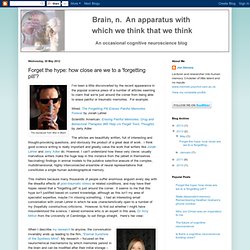
For example: The articles are beautifully written, full of interesting and thought-provoking questions, and obviously the product of a great deal of work. I think good science writing is really important and greatly value the work that writers like Jonah Lehrer and Jerry Adler do. Behavioral Neuroscience Lab Video Lectures by Prof.William Grish. Cerveau&Psycho. Cognitive Neuroscience video lectures by Prof. Richard IVRY. « L’apport freudien » 1Bien que je prenne la liberté de donner pour titre 1 à cet exposé celui de la récente encyclopédie de la psychanalyse qu’a dirigée et publiée chez Bordas, avant que nous ayons la tristesse de le perdre, mon ami Pierre Kaufmann, professeur à Paris X 2, l’objet en sera forcément, dans le cadre de cet enseignement d’initiation, plus limité et plus modeste.

Neuroplasticité. François Ansermet : Neurosciences et psychanalyse. P300 (neuroscience) - eNotes.com Reference. Change your Mind Change your Brain: The Inner Conditions... Psychoneuroimmunology. The word "biofeedback" was coined in the late 1960s to describe laboratory procedures then being used to train experimental research subjects to alter brain activity, blood pressure, heart rate, and other bodily functions that are not normally controlled voluntarily.
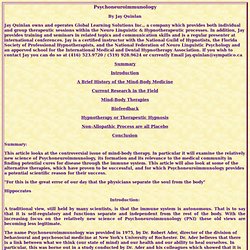
The most common forms of biofeedback today are the electromyographic (EMG) and the electrodermal (EDR). These sensors allow the person to monitor their own muscle relaxation, heart rate, breathing patterns and perspiration and concentrate on changing it through either the visual or auditory information provided by the equipment. The internet: is it changing the way we think? Every 50 years or so, American magazine the Atlantic lobs an intellectual grenade into our culture.

In the summer of 1945, for example, it published an essay by the Massachusetts Institute of Technology (MIT) engineer Vannevar Bush entitled "As We May Think". Physiologie : Neurone - partie 1. Notre cerveau si fantastique (cours) Neuroscience Sheds New Light on Creativity - Rewiring the Creative Mind. Close your eyes and visualize the sun setting over a beach.

How detailed was your image? Did you envision a bland orb sinking below calm waters, or did you call up an image filled with activity -- palm trees swaying gently, waves lapping at your feet, perhaps a loved one holding your hand? Now imagine you're standing on the surface of Pluto. What would a sunset look like from there? Notice how hard you had to work to imagine this scene. Chaos in neurons. Chaos, or deterministic chaos, is ubiquitous in nonlinear dynamical systems of the real world, including biological systems.
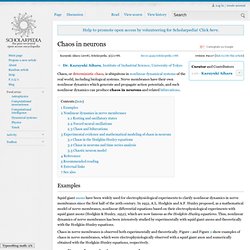
Nerve membranes have their own nonlinear dynamics which generate and propagate action potentials, and such nonlinear dynamics can produce chaos in neurons and related bifurcations. Examples Squid giant axons have been widely used for electrophysiological experiments to clarify nonlinear dynamics in nerve membranes since the first half of the 20th century. Is Neuroscience the Death of Free Will? The Stone is a forum for contemporary philosophers and other thinkers on issues both timely and timeless. Is free will an illusion? Some leading scientists think so. For instance, in 2002 the psychologist Daniel Wegner wrote, “It seems we are agents. Childhood Trauma Leaves Lasting Marks on the Brain. "Common wisdom" has long linked childhood traumas such as physical and sexual abuse to psychopathology later in life.
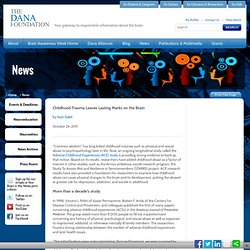
Now, an ongoing longitudinal study called the Adverse Childhood Experiences (ACE) study is providing strong evidence to back up that notion. Based on its results, researchers have added childhood abuse as a factor of interest in other studies, such as the Army’s ambitious suicide research program, the Study To Assess Risk and Resilience in Servicemembers (STARRS) project. ACE research results have also provided a foundation for researchers to examine how childhood abuse can cause physical changes to the brain and its development, putting the abused at greater risk for depression, addiction, and suicide in adulthood. More than a decade's study In 1998, Vincent J.
Le trauma et le Chaos psychologique. La maltraitance infantile marque le cerveau. Un cours de Gustavo Turecki en 2010-Partie 1. La maltraitance infantile marque le cerveau. Un cours de Gustavo Turecki en 2010-Partie 2. CHD5, a Brain-Specific Paralog of Mi2 Chromatin Remodeling Enzymes, Regulates Expression of Neuronal Genes. CHD5 is frequently deleted in neuroblastoma and is a tumor suppressor gene.
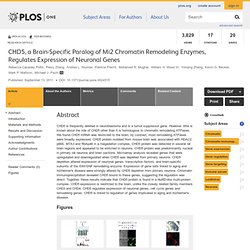
However, little is known about the role of CHD5 other than it is homologous to chromatin remodeling ATPases. Neuroscience Department - Nestler Lab Projects. A role for CREB in emotional regulation first came from studies of the locus coeruleus, the major noradrenergic nucleus in brain, where we showed that chronic opiate administration induced the CREB pathway to mediate physical aspects of opiate dependence and withdrawal. Fédération pour la Recherche sur le Cerveau. Study finds psychopaths have brain abnormalities. Updated Tue 8 May 2012, 8:05am AEST Scientists who scanned the brains of men convicted of murder, rape and violent assaults have found the strongest evidence yet that psychopaths have structural abnormalities in their brains.
The researchers, based at King's College London's Institute of Psychiatry, said the differences in psychopaths' brains separate them distinctly from other violent criminals with anti-social personality disorders (ASPD), and from healthy non-offenders. Interest in what goes on inside the heads of violent criminals has been sharpened by the trial of Anders Behring Breivik, the Norwegian who massacred 77 people last July. Mirrorbox: The Story of How Art Became Science. Existe-t-il une génétique des comportements ? - Philip Gorwood.